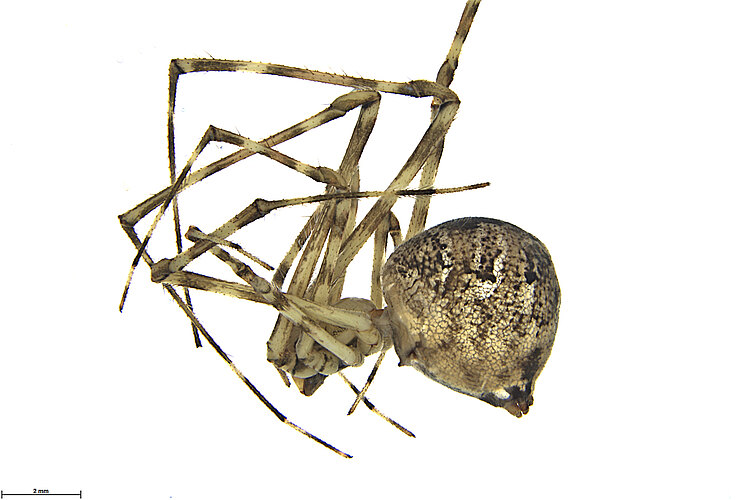Giant Comb-footed Spider Cryptachaea gigantipes (Keyserling, 1890)
Fauna Portal species: 6381Diagnosis
(after Smith et al. 2012): The legs of C. gigantipes are far longer than those of related species currently known from Australia or New Zealand: the femur and tibia of leg I are each longer than (male) or subequal to (female) the total body length. Male, pedipalp tibia elongate and subequal to cymbium length (half or a third as long in C. veruculata and C. blattea, respectively). Epigynum with a pair of heavily sclerotised, peg-like protrusions that form a deep U-shape in posterior view; the shape of these protrusions distinguishes the species from C. veruculata in which the protrusions are smaller and more horn-shaped.
Status
- native
Linnean Holotype
Australia
- Australian Capital Territory
- New South Wales
- Norfolk and Lord Howe Islands
- Queensland
- Tasmania
- Victoria
Neighbouring Countries
- New Zealand
Fauna Portal Records
The map shows all records that have been verified as part of the Fauna Portal project and may not represent the true distribution of a species. Specifically, for described species, check the link to the Atlas of Living Australia on this page for potential wider distributions. Fauna Portal Reference specimens and Linnean types are shown in red. If you identified a specimen that exceeds the distribution of an undescribed species as illustrated here, please contact the Fauna Portal team who can assist with the lodgement of the specimen in a public institution and display on the map.
Publications
Smith HM, Vink CJ, Fitzgerald BM, Sirvid PJ (2012): Redescription and generic placement of the spider Cryptachaea gigantipes (Keyserling, 1890) (Araneae: Theridiidae) and notes on related synanthropic species in Australasia. Zootaxa. 3507: 38 - 56
Araneae (Spiders)
- Actinopodidae
- Anamidae
- Araneae fam. indet.
- Araneidae
- Archaeidae
- Argyronetidae
- Arkyidae
- Barychelidae
- Cheiracanthiidae
- Clubionidae
- Corinnidae
- Cycloctenidae
- Deinopidae
- Desidae
- Dictynidae
- Filistatidae
- Gnaphosidae
- Halonoproctidae
- Hersiliidae
- Idiopidae
- Lamponidae
- Linyphiidae
- Lycosidae
- Mimetidae
- Miturgidae
- Mysmenidae
- Nicodamidae
- Oecobiidae
- Oonopidae
- Oxyopidae
- Philodromidae
- Pholcidae
- Pisauridae
- Prodidomidae
- Salticidae
- Scytodidae
- Segestriidae
- Selenopidae
- Sparassidae
- Symphytognathidae
- Tetrablemmidae
- Tetragnathidae
- Theridiidae
- Thomisidae
- Trachelidae
- Trachycosmidae
- Trochanteriidae
- Uloboridae
- Zodariidae
- Zoropsidae
All classes
- Arachnida
- Crustacea
- Entognatha
- Gastropoda
- Insecta
- Orthoptera - Caelifera (Grasshoppers)
- Hymenoptera excl. Formicidae (bees and wasps)
- Blattodea s. str. (Cockroaches)
- Coleoptera (Beetles)
- Dermaptera (earwigs)
- Diptera (flies, mosquitos)
- Entomobryomorpha (slender springtails)
- Hemiptera - Heteroptera (True Bugs)
- Hemiptera - Sternorrhyncha (aphids, scales etc.)
- Hemiptera - Auchenorrhyncha (cicadas, planthoppers)
- Hymenoptera - Formicidae (Ants)
- Trichoptera (Caddisflies)
- Zygentoma (silverfish)
- Myriapoda

